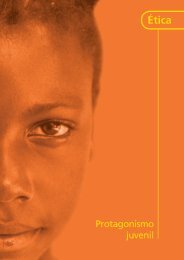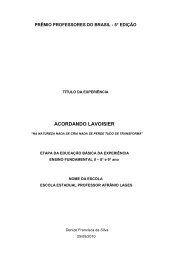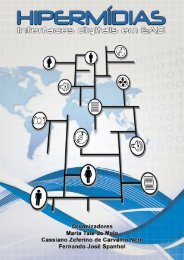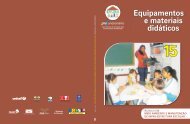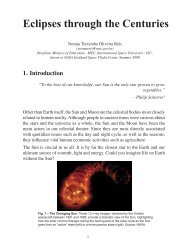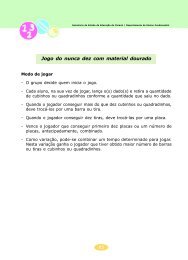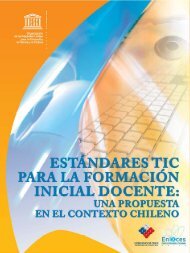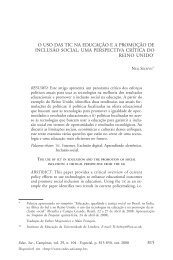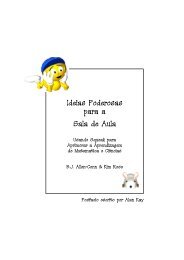BIO-CULTURAL COMMUNITY PROTOCOLS - Portal do Professor
BIO-CULTURAL COMMUNITY PROTOCOLS - Portal do Professor
BIO-CULTURAL COMMUNITY PROTOCOLS - Portal do Professor
You also want an ePaper? Increase the reach of your titles
YUMPU automatically turns print PDFs into web optimized ePapers that Google loves.
APPENDIX RAIKA <strong>BIO</strong>-<strong>CULTURAL</strong> PROTOCOL<br />
Principle 3: Our traditional breeds represent<br />
collective property, products of local knowledge<br />
and cultural expression of the Raika.<br />
While the Raika have collective custodianship rights over<br />
our breeds and the genetic traits of these breeds, it is crucial<br />
that these rights are supported and promoted by the<br />
government. Our government must therefore respect,<br />
preserve and maintain the knowledge, innovations and<br />
practices of the Raika embodying lifestyles relevant for<br />
sustainable use and conservation of livestock diversity.<br />
Principle 3 is supported by:<br />
Article 8 (j) of the Convention on Biological Diversity:<br />
“Contracting parties shall…subject to national legislation,<br />
respect, preserve and maintain knowledge innovations and<br />
practices of indigenous and local communities embodying<br />
traditional lifestyles relevant for the conservation<br />
and sustainable use of biological diversity…“<br />
Article 10 (c) of the Convention on Biological Diversity:<br />
“customary use of biological resources is protected and<br />
encouraged in accordance with traditional cultural<br />
practices that are compatible with conservation and<br />
sustainable use requirements”...<br />
Chapter 15 (4) (g) of Agenda 21 calls on governments at the<br />
appropriate level “to recognize and foster the traditional<br />
methods and knowledge of indigenous people and their<br />
communities… relevant to the conservation of biological<br />
diversity and the sustainable use of biological resources”.<br />
Chapter 15 (5) (e) of Agenda 21: Governments should<br />
“subject to national legislation, take action to respect,<br />
record, protect and promote the wider application of the<br />
knowledge, innovations and practices of indigenous and local<br />
communities embodying traditional lifestyles for the<br />
conservation of biological diversity and the sustainable<br />
use of biological resources …” Based on these principles<br />
articulated and implicit in existing legal instruments and<br />
international agreements, the Raika who belong to a traditional<br />
livestock keeping community and adhere to ecological principles<br />
of animal production affirm the following rights:<br />
1. The Raika have the right to make breeding<br />
decisions and breed the breeds they maintain.<br />
This right is supported by:<br />
Article 10 (c) of the Convention on Biological Diversity: obliges<br />
Parties to “protect and encourage customary use of biological<br />
resources in accordance with traditional cultural practices<br />
that are compatible with conservation and sustainable<br />
use requirements”.<br />
2. The Raika shall have the right to<br />
participate in policy formulation and<br />
implementation processes on animal<br />
genetic resources for food and agriculture.<br />
This right is supported by:<br />
Article 8 (j) of the Convention on Biological Diversity:<br />
obliges Parties to “promote the wider application of the<br />
knowledge, innovations and practices of indigenous and<br />
local communities with their approval and involvement”.<br />
Article 14(1) (a) of the Convention on Biological Diversity:<br />
obliges Parties to “introduce appropriate procedures requiring<br />
environmental impact assessment of its proposed projects<br />
that are likely to have significant adverse effects on biological<br />
diversity with a view to avoiding or minimizing such effects<br />
and where appropriate allow for public participation in<br />
such procedures”.<br />
Article 3 (a) of the United Nations Convention on<br />
Desertification: compels Parties to “ensure that decisions on<br />
the design and implementation of programmes to combat<br />
desertification and/or mitigate the effects of drought are<br />
taken with the participation of populations and local<br />
communities and that an enabling environment is<br />
created at higher levels to facilitate action at national<br />
and local levels”.<br />
Article 10(2) (f ) of the United Nations Convention on<br />
Desertification: obliges the “effective participation at the<br />
local, national and regional levels of non- governmental<br />
organizations and local populations, both women and men,<br />
particularly resource users, including farmers and<br />
pastoralistsand their representative organizations, in<br />
policy planning, decision-making, and implementation<br />
and review of national action programmes”.<br />
86




